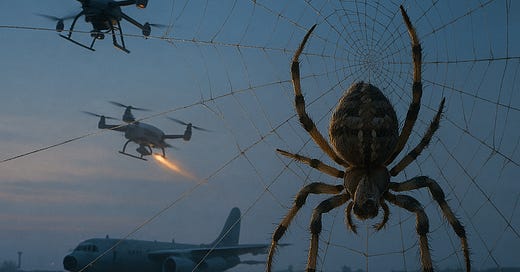This article is part of “Operation Spider’s Web,” a five-part report examining Ukraine’s long-range sabotage strike on Russian bomber bases.
When the smoke cleared, what remained was a crater in Russia's strategic air power. For once, Ukraine's claim of success wasn't just a press release. It was visible from space.
Satellite imagery of Belaya airbase, taken the day after the strike, showed the charred remains of long-range bombers. Independent analysts counted at least eight aircraft destroyed on the tarmac—a mix of Tu-95MS Bears and Tu-22M3 Backfires. The estimated value of damage at that site alone? Over $400 million.
But Belaya was just one of four airfields hit.
Targets Confirmed
Across the full strike zone, Ukrainian and independent sources confirmed the following:
Belaya Airbase (Irkutsk Oblast): At least 8 long range bombers destroyed.
Olenya Airbase (Murmansk Oblast): Multiple Tu-22M3s hit; significant secondary explosions reported
Dyagilevo Airbase (Ryazan Oblast): Fire damage to several aircraft; drone debris also struck civilian structures
Ivanovo Airfield (Ivanovo Oblast): Outcome unclear; Russia claimed the attack was repelled, Ukraine claims hits
Ukrainian intelligence sources say more than 40 aircraft were damaged or destroyed across the four sites, including a rare A-50 airborne radar plane—a critical asset for Russian battlefield coordination. If that number holds, it would represent more than a third of Russia's functional long-range bomber fleet.
What Was Destroyed
The aircraft hit weren't just runways full of metal. They were the sharpest tools in Russia’s long-range arsenal—each one representing a threat not only to Ukraine, but to NATO's eastern flank, shipping routes in the Black Sea, and strategic infrastructure across Eastern Europe.
Tu-95MS 'Bear': These four-engine turboprop bombers date back to the Cold War, but have been modernized to carry Kh-101 and Kh-555 air-launched cruise missiles with ranges of up to 2,500 kilometers. From safe positions inside Russian airspace, they’ve launched repeated salvos against Ukrainian cities and power grids. These bombers were responsible for much of the destruction during Russia's winter campaigns—striking Kyiv, Kharkiv, and Dnipro from as far away as the Caspian Sea.
Tu-22M3 'Backfire': A supersonic, variable-sweep bomber designed for both anti-ship and ground attack missions. It carries Kh-22 and Kh-32 missiles—capable of destroying warships or hardened ground targets. In Ukraine, it's been used to target civilian infrastructure, rail hubs, and large troop concentrations. Notably, Tu-22M3s played a key role in the brutal early assaults on Mykolaiv and the Azovstal steelworks in Mariupol, where Ukrainian defenders held out for weeks under near-constant bombardment. It’s also a strategic asset in the Black Sea and eastern Mediterranean.
A-50U 'Mainstay': Russia’s airborne early warning and control (AWACS) aircraft. With its rotating radar dome, it can track hundreds of aerial targets at once and direct interceptors in real time. It’s been vital to Russian air operations over Ukraine and Syria. With only a handful in service, the confirmed or suspected loss of an A-50 isn’t just tactical—it blinds Russia’s air force in multiple theaters.
Each destroyed aircraft represents more than a hole in the tarmac. It’s a gap in Russia’s ability to coordinate air strikes, threaten NATO’s periphery, and maintain air superiority over contested territory.
Strategic Cost
The SBU estimated the total financial cost of the operation at $7 billion in damages to Russia. That figure includes destroyed aircraft, disrupted operations, and munitions lost in secondary detonations.
More importantly, it delivered a psychological cost. Russia’s most protected airfields—hundreds and even thousands of kilometers from the front line—were shown to be vulnerable to cheap, improvised drones launched from within their own territory. As one Western military analyst put it, "Russia's long-range aviation has suffered a strategic defeat without a single Ukrainian fighter leaving its airspace."
The New Weapon Economy
Each FPV drone reportedly cost Ukraine between $400 and $1,000 to build and deploy. They were guided by operators using nothing more sophisticated than a video headset and a gamepad.
Compare that to a $35 million bomber.
Ukraine didn't just destroy aircraft. It reversed the math of the war. It proved that, with ingenuity and placement, a $1,000 drone can take out a military asset worth thousands of times more. And it proved that Russia's air superiority isn't just at risk over the battlefield—it's crumbling in the parking lot.
And that kind of bite? Hurts more than the sting.
→ Continue to Part IV: The Web Tightens
or Return to Index






Fight smarter and cheaper.
Not more expensively.
The US has proven for years that their technologically superior military is meaningless, as they’ve consistently lost war after war against “inferior” forces.
Russia and Putin are no different. They believe themselves invulnerable and Ukraine just proved them wrong.
Russia and USA’s arrogance has once again proven their undoing.
Way to go Ukraine! 🇺🇦
Appreciate learning the details. Thanks.
Mind boggling accomplishment by Ukraine.